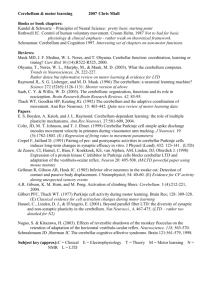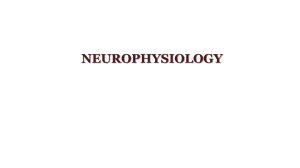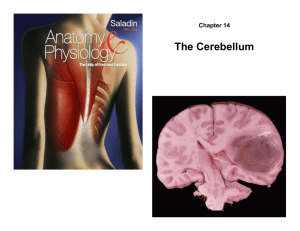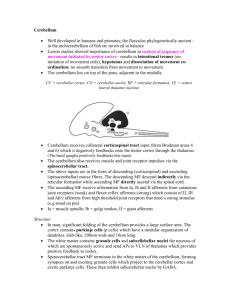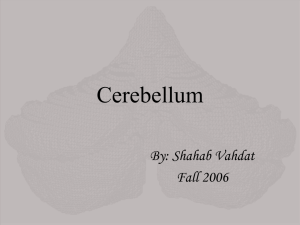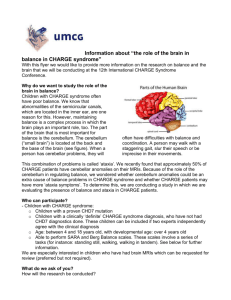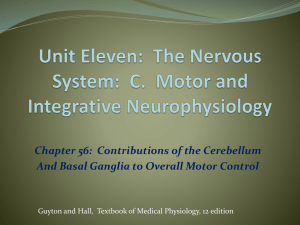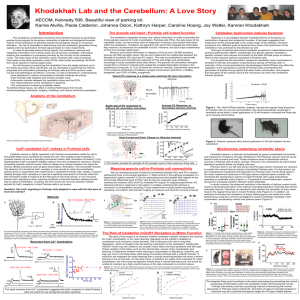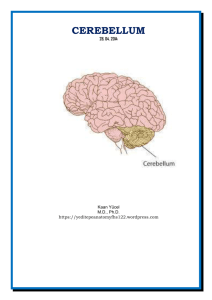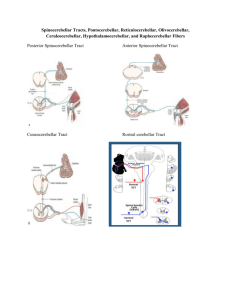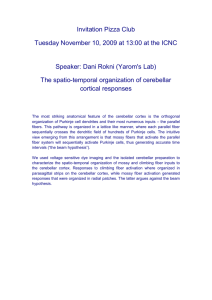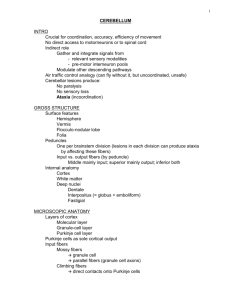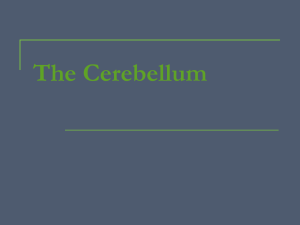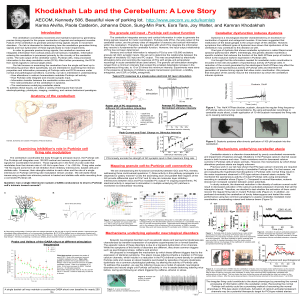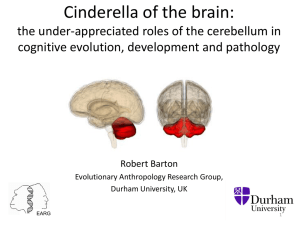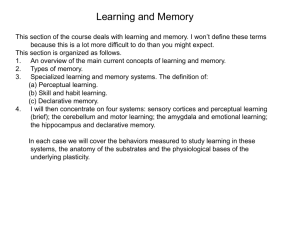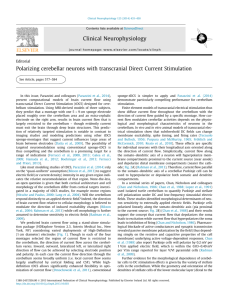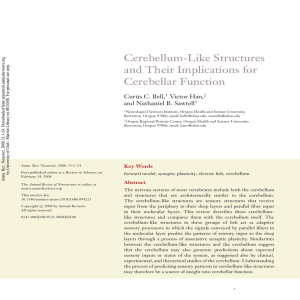The cerebellum, the vestbulo-ocular reflex and motor learning
advertisement
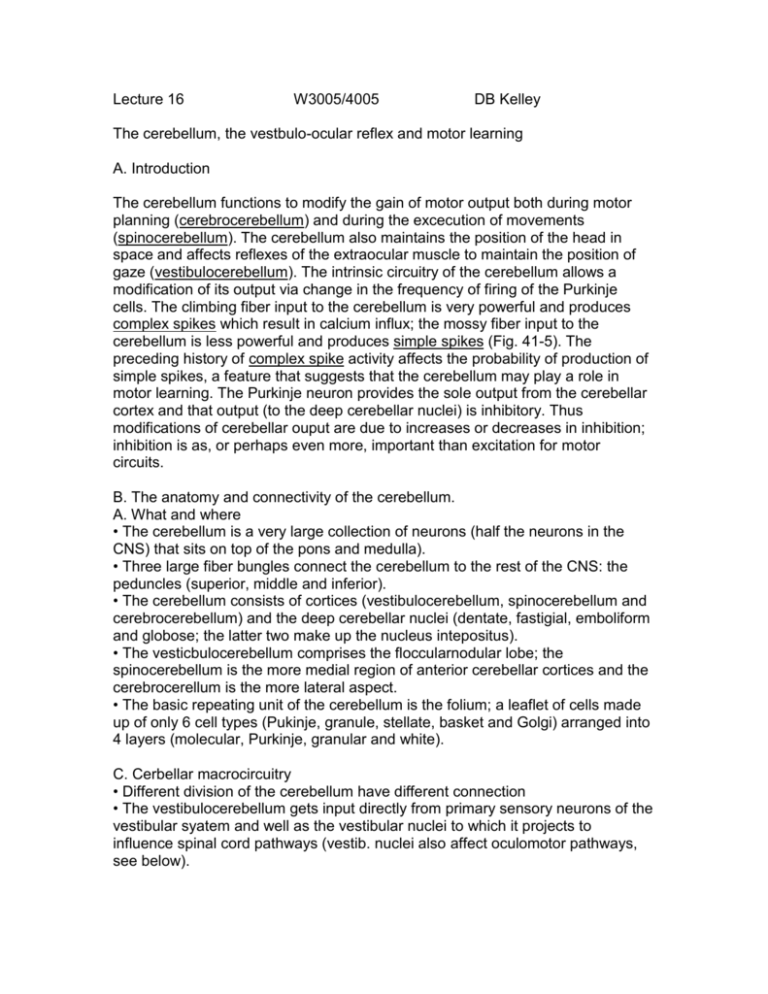
Lecture 16 W3005/4005 DB Kelley The cerebellum, the vestbulo-ocular reflex and motor learning A. Introduction The cerebellum functions to modify the gain of motor output both during motor planning (cerebrocerebellum) and during the excecution of movements (spinocerebellum). The cerebellum also maintains the position of the head in space and affects reflexes of the extraocular muscle to maintain the position of gaze (vestibulocerebellum). The intrinsic circuitry of the cerebellum allows a modification of its output via change in the frequency of firing of the Purkinje cells. The climbing fiber input to the cerebellum is very powerful and produces complex spikes which result in calcium influx; the mossy fiber input to the cerebellum is less powerful and produces simple spikes (Fig. 41-5). The preceding history of complex spike activity affects the probability of production of simple spikes, a feature that suggests that the cerebellum may play a role in motor learning. The Purkinje neuron provides the sole output from the cerebellar cortex and that output (to the deep cerebellar nuclei) is inhibitory. Thus modifications of cerebellar ouput are due to increases or decreases in inhibition; inhibition is as, or perhaps even more, important than excitation for motor circuits. B. The anatomy and connectivity of the cerebellum. A. What and where • The cerebellum is a very large collection of neurons (half the neurons in the CNS) that sits on top of the pons and medulla). • Three large fiber bungles connect the cerebellum to the rest of the CNS: the peduncles (superior, middle and inferior). • The cerebellum consists of cortices (vestibulocerebellum, spinocerebellum and cerebrocerebellum) and the deep cerebellar nuclei (dentate, fastigial, emboliform and globose; the latter two make up the nucleus intepositus). • The vesticbulocerebellum comprises the floccularnodular lobe; the spinocerebellum is the more medial region of anterior cerebellar cortices and the cerebrocerellum is the more lateral aspect. • The basic repeating unit of the cerebellum is the folium; a leaflet of cells made up of only 6 cell types (Pukinje, granule, stellate, basket and Golgi) arranged into 4 layers (molecular, Purkinje, granular and white). C. Cerbellar macrocircuitry • Different division of the cerebellum have different connection • The vestibulocerebellum gets input directly from primary sensory neurons of the vestibular syatem and well as the vestibular nuclei to which it projects to influence spinal cord pathways (vestib. nuclei also affect oculomotor pathways, see below). • The spinocerebellum gets spinal and vestibular nuclei and its Purkinje cells project to the fastigial and interpositus nuclei. • The spinocerebellum has several complete maps of the body surface (Fig. 419); some are fractured • The cerebrocerebellum gets input from pontine nuclei that themselves are afferented by collaterals of neurons in the corticospinal tract. The output of the cerebrocerebellum via the dentate nucleus to the thalamus and then to motor cortex and premotor areas. D. Cerbellar microcircuitry • There are two major inputs to the cerebellum: climbing fibers (which come from the inferior olive) and mossy fibers (which come from everywhere else). • These form distinctive types of terminals on their target cells (mostly granule cells for mossy fibers and Purkinje cells for climbing fibers). • The granule cells give rise to parallel fibers which make synapses on the dendritic trees (oriented by 90 degrees to the climbing fibers) of Purkinje cells; each Purkinje cells receives ~200,000 parallel fiber inputs. • The climbing fibers synapse directly on the Purkinje cell bodies; each Purkinje cells receives input from a single climbing fiber and each climbing fiber innervates, at most, 10 Purkinje cells. • Inhibitory interneurons (eg. basket cells) sharpen the beam of parallel fiber excitation E. Functions of the cerebellum 1. Cerebrocerebellum • Lesions of the dentate or of overlying cortex produce deficits in initiating movements and in coordinating arm and leg movements (Fig. 41-130. • Primate studies reveal that when the dentate is inactivated both the discharge of neurons in primary motor cortex and the initiation of associated movements is delayed. • Rapid movements are characteristically overshot; terminal tremor results. • Perceptual judgements of tone duration are also disrupted implying that cerebellum functions also in cognition. 2. Spinocerebellum • Information about ongoing movements are provided by information originating in the dorso spinocerbellar tract while information in the ventral spinocerbellar tract conveys information on CNS motor pattern generation and spinal circuit activation. • The spinocerebellum insures that movements are smooth by adjusting neural output to compensate for changes in load. • Lesions result in decreased activity of gamma motor neurons. 3. Vestibulocerebellum • In addition to vestibular inputs, the vestibulocerebellum also receives auditory and visual information. •The vestibulocerebellum adjusts the gain of output to motor neurons that control the position of the eyes in space so as to maintain gaze. • The vestibuloocular reflex • Learning and the vestibuloocular reflex; the Ito hypothesis.
